
Passiflora, known also as the passion flowers or passion vines, is a genus of about 550 species of flowering plants, the type genus of the family Passifloraceae.

Heliconius charithonia, the zebra longwing or zebra heliconian, is a species of butterfly belonging to the subfamily Heliconiinae of the family Nymphalidae. It was first described by Carl Linnaeus in his 1767 12th edition of Systema Naturae. The boldly striped black and white wing pattern is aposematic, warning off predators.
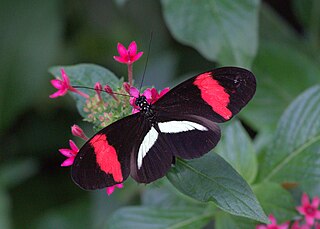
Heliconius erato, or the red postman, is one of about 40 neotropical species of butterfly belonging to the genus Heliconius. It is also commonly known as the small postman, the red passion flower butterfly, or the crimson-patched longwing. It was described by Carl Linnaeus in his 1758 10th edition of Systema Naturae.

Heliconius cydno, the cydno longwing, is a nymphalid butterfly that ranges from Mexico to northern South America. It is typically found in the forest understory and deposits its eggs on a variety of plants of the genus Passiflora. It is a member of the Heliconiinae subfamily of Central and South America, and it is the only heliconiine that can be considered oligophagous. H. cydno is also characterized by hybridization and Müllerian mimicry. Wing coloration plays a key role in mate choice and has further implications in regards to sympatric speciation. Macrolide scent gland extracts and wing-clicking behavior further characterize this species.
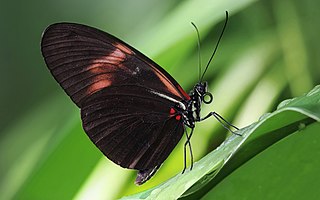
Heliconius melpomene, the postman butterfly, common postman or simply postman, is a brightly colored butterfly found throughout Central and South America. It was first described by Carl Linnaeus in his 1758 10th edition of Systema Naturae. Its coloration coevolved with a sister species H. erato as a warning to predators of its inedibility; this is an example of Müllerian mimicry. H. melpomene was one of the first butterfly species observed to forage for pollen, a behavior that is common in other groups but rare in butterflies. Because of the recent rapid evolutionary radiation of the genus Heliconius and overlapping of its habitat with other related species, H. melpomene has been the subject of extensive study on speciation and hybridization. These hybrids tend to have low fitness as they look different from the original species and no longer exhibit Müllerian mimicry.
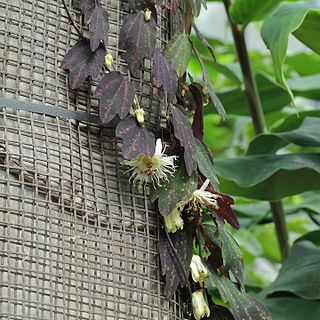
Passiflora telesiphe is a species of flowering plant in the family Passifloraceae. It is endemic to Ecuador.

Heliconius doris, the Doris longwing or Doris is a species of butterfly in the family Nymphalidae. It is known for being a polymorphic species which participates in various Müllerian mimicry rings throughout Central America and the Amazon rainforest. It is a species of special interest in biological science for the genetic basis and role of polymorphism (biology) in ecology and evolution.
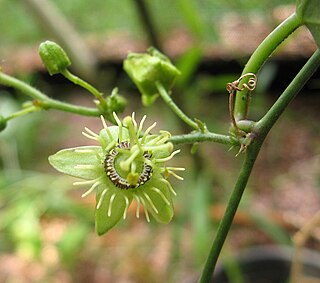
Passiflora suberosa is a species of passionflower that is native to the Americas. Its range stretches from Florida and the Lower Rio Grande Valley of Texas in the United States south through Mexico, Central America, and the Caribbean to South America. It is commonly known as corkystem passionflower due to the corkiness of older stems. The fruit is not hardy and transitions from green to indigo, purple and, lastly, black as it ripens. This species is a host plant for the caterpillars of the Gulf fritillary, Julia heliconian, Mexican silverspot, red postman, and zebra heliconian. It is a larval host plant for the glasswing butterfly in Australia.

Heliconius hecalesia, the five-spotted longwing, is a species of butterfly of the family Nymphalidae. It is found from Central America to Venezuela and Ecuador.

Heliconius numata, the Numata longwing, is a brush-footed butterfly species belonging to the family Nymphalidae, subfamily Heliconiinae.

Eueides isabella, the Isabella's longwing or Isabella's heliconian, is a species of nymphalid butterfly, belonging to the Heliconiinae subfamily.

Heliconius antiochus, the Antiochus longwing, is a butterfly of the family Nymphalidae. It was described by Carl Linnaeus in 1767. It is found from Panama to the Amazon region. The habitat consists of riparian forests.
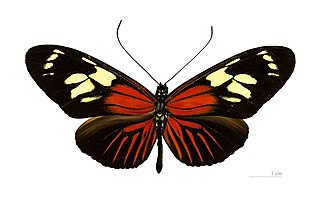
Heliconius burneyi, the Burney's longwing, is a butterfly of the family Nymphalidae. It was described by Jacob Hübner in 1831. It is found in the Amazon basin. The habitat consists of tall forests.

Heliconius demeter, the Demeter longwing, is a butterfly of the family Nymphalidae. It was described by Otto Staudinger in 1897. It is found in the Northern and Eastern part of the Amazon basin, from Guyana to Northern Brazil and Peru. The habitat consists of sandy rainforests.

Heliconius elevatus is a butterfly of the family Nymphalidae. It was described by Nöldner in 1901. It is found in the Amazon Basin. The habitat consists of riparian forests.

Heliconius ethilla, the ethilia longwing, is a butterfly of the family Nymphalidae. It was described by Jean-Baptiste Godart in 1819. It is found from Panama to southern Brazil. The habitat consists of marginal forests.

Heliconius ricini, the ricini longwing, is a butterfly of the family Nymphalidae. It was described by Carl Linnaeus in 1758. It is found from Venezuela and Trinidad to the Guianas and northern Brazil. The habitat consists of savanna-type areas.

Heliconius aoede, the Aoede longwing, is a species of butterfly of the family Nymphalidae. It was described by Jacob Hübner in 1813. It is found in the Amazon basin. The habitat consists of deep forests.

Heliconius wallacei, the Wallace's longwing, is a butterfly of the family Nymphalidae. It was described by Tryon Reakirt in 1866. It is found from Venezuela and Trinidad to southern Brazil and Peru. The habitat consists of lowland rainforests.

Heliconius eratosignis, the eratosignis longwing, is a butterfly of the family Nymphalidae. It was described by James John Joicey and George Talbot in 1925. It is found in the south-western Amazon basin, from Brazil to Peru and Bolivia. The habitat consists of sandy rainforests.







